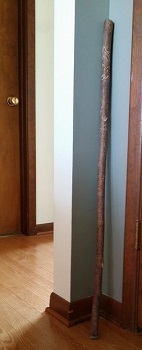The fort is impressive. A sturdy riverbank willow, felled a good six foot above the ground by heavy flooding, forms the natural backbone of the debris shelter. The ZRF (Zombie Resistance Force) troops, some raw recruits and other battle hardened veterans of past years’ skirmishes with the undead, have spent most of their morning framing out their survival shelter with whatever deadfall limbs they could gather from the remote riverbank –preferably willow, if they can find it. Willow is, after all, the “tree of life” and therefore anathema to the undead monsters that cannot bear its regenerative life-giving properties.
Any Zombie Camp vet knows the untold power of the willow tree. Healers used it to relieve pain and bring down fever. Survivalists use it to make tools such as baskets and fish traps. Environmentalists plant it along waterways to control erosion or to clean soil polluted by heavy metals. Generations of our forefathers carved it on their tombstones as the sign of eternal life, for the willow tree is one of the few that will sprout new growth from a seemingly dead stick.
For all of those reasons, it is a fitting talisman to wield against the zombie hoards.
Over the course of a single week, 30 children who arrive at our doorstep in varying states of anxiety at the prospect of separation from electronic gaming systems somehow end up trading the addiction of the joystick for the solid comfort of the walking stick (preferably willow, they compare it against mine to make sure). I firmly believe that there is no amount of lecturing or forbidding, no power in the universe that can stop a stick from ending up in the hands of a child over the course of a twenty minute walk through the woods.
There is a magical simplicity in it. A stick can be anything from a sword to a wizard’s staff and more. The possibilities are as limitless as the imagination, and that is the key to my most successful children’s programs: remembering and rediscovering the child that I myself once was. Freeman Tilden, a pioneer in the field of museum and naturalist interpretation decreed that “interpretation addressed to children should not be a dilution of the presentation to adults, but should follow a fundamentally different approach. To be at its best, it will require a separate program.”
For me, that program is Zombie Survival Camp, a week long day camp in which children learn basic wilderness survival skills, emergency disaster planning and teamwork all while fighting off occasional attacks from what I call “real” fake zombies. Holding it all together is a dedicated staff, a lot of creativity, and lesson plans with a range of activities that could be described as flexible on a good day and “flying by the seat of our pants,” on particularly challenging days when Mother Nature refuses to cooperate.
My secret weapon, however, is something without which I would never dream of delving into Zombie infested territory; let alone a group of eager 8-12 year old zombie slayers. It is an object both simple and complex: a well-seasoned length of wood, carved with crude designs depicting the mystical powers of the willow. Just as the ancient Druids collected and carved their knowledge into the walking sticks of their wandering bards, this is my own Wizard’s staff, and with it I wield immense power.

At Zombie Survival Camp kids trade joysticks for real sticks and connect with nature and their imaginations in new ways
A few thumps of the “Zombie Stick” on the weathered boards of the village walkways quickly silences chatting troops. It raps the beat to the Zombie Camp drill cadence as the children march through the woods and rallies scattered forces in the midst of chaos. In the heat of the final, epic battle with the undead, only the Zombie Stick (properly wielded in my hand, of course) has the power to force back the ravenous brain-eaters, allowing a fearful child safe passage from the battle front or giving troops time to regroup in a tactical situation gone wrong.
Perhaps, years from now, some aged Zombie Camp veteran will pause a moment and reconsider before clearing a tangled patch of rough gray river willow flourishing beside a stream or wetland. And if instead they take a moment to show their own child how to strip the bark and fashion a toy bow and arrow or build their own zombie-proof fortress, then the true magic of my Wizard’s staff will finally be realized.
Ann Cejka, is a creative and passionate program coordinator at Iowa’s Cedar Rapids Parks and Recreation Department.

